Faculty Lecturers 1989-1999
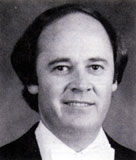
Jack R. Ullom, D.M.A. JACK R. ULLOM grew up in San Leandro, California, where he took advantage of the outstanding music programs in area public schools. He was valedictorian of his high school graduating class and took his early musical training at San Jose State University in violin and music education, where he graduated magna cum laude, with honors in music. He was awarded a Woodrow Wilson National Fellowship to study music history at Stanford University and completed doctoral studies in violin and music history at the University of Oregon. In addition, he has pursued conducting studies with Gibson Walters, Stanley Chapell and Richard Lert.
Dr. Ullom began his teaching career at Hillsdale High School in San Mateo and moved to Santa Barbara in 1969 to become the Santa Barbara City College Symphony conductor. While at SBCC, he has enjoyed teaching musicianship, music appreciation, music history and the symphony orchestra. He has served the college for many years as Chair of the Professional Standards Committee and President of the Instructors' Association. Presently, he is Chair of the Fine Arts Division and the Music Department.
WHILE AT SBCC, Dr. Ullom has received two research grants from the Chancellor's Office of the California Community Colleges and has published Line Scores for Aural Analysis and a series of innovative music history computer programs that utilize the latest laserdisc technology. These programs have significantly increased the achievement of music history and appreciation students at SBCC and have received national recognition for their effectiveness.
The lecturer has played in the Santa Barbara Symphony for 19 years and serves as Chair of the Advisory Committee for the Pillsbury Foundation that awards grants to young Santa Barbara musicians to aid them in the pursuit of their musical studies. He performs regularly with his own professional string trio, Tres a cordes. During each summer, he travels to Southern Oregon State College to teach at a chamber music workshop.
DR. ULLOM LIVES in Carpinteria, where he enjoys the beach and the mountains with his wife, the former Bernice Colombana, Supervisor of Admissions and Records at SBCC. His two daughters, Katherine and Melissa. 11 and 8, respectively, are students at Roosevelt Elementary School.
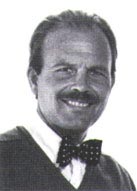
CURTIS B. SOLBERG is a "son of the Middle Border," a Norwegian-American whose grandparents migrated as pioneers to North Dakota prior to 1900. At the age of nine, he and his family moved to Vallejo, California, where he lived until his matriculation to the University of California at Santa Barbara in 1957. He majored in history at UCSB, earning his B.A., M.A. and Ph.D. degrees.
Dr. Solberg joined the History Department faculty of Santa Barbara City College in 1965. He has also taught at Northeastern University, Boston, and at two universities in Norway. In 1971, he served as a lecturer in a USIS/Fulbright lecture series in Scandinavia.
THE LECTURER's research interests are varied. His publications includeMinorities in California History and The Pollution Papers (both co-edited with Dr. George Frakes), and A People's Heritage (co-authored with David Morris), as well as scholarly articles and book reviews published in the United States and Europe. He wrote his Ph.D. dissertation on "As Others Saw Us: Travelers in America During the Age of the American Revolution."
During the past decade, Professor Solberg has been engaged in the translation of thousands of immigrants' letters discovered in the Royal Archives in Oslo, Norway. This correspondence illuminates our understanding of America during a century (1840-1930) of unprecedented growth.
THE CULTIVATION OF his ethnic roots was activated by a visit to his ancestral homeland in 1961, affording an opportunity to rekindle pre-20th century familial connections and to master the rudiments of the Norwegian language. He has served as president of both the Santa Barbara lodge of the Sons of Norway and the local chapter of the American-Scandinavian Foundation. He is also an active member of the Norwegian-American Historical Association.
Dr. Solberg's daughters were both Santa Barbara City College students. Kaaren, married to a U.S. Navy lieutenant, resides in New Jersey. Christina, a recent University of California, Berkeley graduate in Chinese Studies, is preparing to return for a two-year stay in the People's Republic of China.
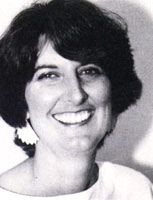
DIANE JOHNSON HANDLOSER grew up in Northern California, where she attended Folsom High School and the University of California at Davis. A childhood fascination with her family's French heritage led her to a major in political science, with an emphasis in European government, and a minor in French. During her junior year in college while studying at the Institut d'Etudes Politiques of the University of Bordeaux, France, she discovered what would become her overriding interest in the history of art. History came alive for her with new intensity while walking the narrow streets of Vezelay, wandering through the galleries of the Louvre, and gazing at the frescoes of Giotto in Padua.
Upon return to UC, Davis, she completed her political science degree, and began her formal study of the history of art. In 1967, she contributed to the catalogue of the exhibition France and California: The Impact of French Art and Culture on Early California. She then moved to UCLA in art history, supported by an NDEA fellowship for future college teachers. A grant in 1969 facilitated further travel in Europe to research her thesis on Northern Renaissance iconography. In 1970, she received a Master's Degree in the History of Art.
SHE JOINED the faculty of Santa Barbara City College in 1970, and is currently Professor of the History of Art. She has served on numerous college committees through the years, chairing the Improvement of Instruction Committee, and serving as chair of the Art Department. A devoted teacher, Diane has involved herself in activities which most directly support her work in the classroom.
Extensive travel and photography of art historical sites and monuments (such as the Gothic cathedrals of France, and ancient sites like Mycenae, Epidaurus and Olympia in Greece) have enhanced not only her own understanding, but have enriched the visual slide library used by the Art Department.
SHE HAS RECEIVED numerous Faculty Enrichment and Improvement of Instruction grants for teaching innovations. She was recently involved in the federally funded LARC/FIPSE grant for the Instructional Improvement Project on Classroom Research. She co-authored with Music Professor Jack Ullom the art history component of a laser disc program used in SBCC Music Appreciation classes. She has been on the faculty of the Honors Program since its inception. In 1990, she was voted Outstanding Faculty Member of the Santa Barbara City College Honors Program.
During her 1990-1991 sabbatical, she spent her time in study and travel aimed at revising the curriculum of SBCC's Art Appreciation course to include more examples of world art. To that end, she visited archeological sites, such as Teotihuacan and the Templo Mayor in Mexico City, as well as the National Museum of African Art in Washington, D.C. and the Precolumbian, African and Asian collections in New York City. She is an active member of Friends of Ethnic Art and the Contemporary Arts Forum, and currently serves on the Education Committee of the Santa Barbara Museum of Art.
DIANE HANDLOSER MARRIED John S. Handloser, Jr. in 1973. He is Vice President of Far West Technology in Goleta. They have two children, Hope 13, and Gretchen, 10. Diane enjoys being involved in the children's school and sports activities, and spends weekends working with her husband on the restoration of their old Spanish–style house.
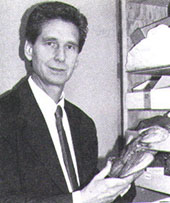
ROBERT J. CUMMINGS was born and raised in Southern California. His early years included ample introduction to natural history and led unwaveringly to his life as a biologist and teacher. He came to Santa Barbara in 1962 to attend the University of California at Santa Barbara. He received his Bachelor of Arts in Biological Sciences in 1966, and continued at UCSB in Dr. Ian Ross' laboratory, earning a Master of Arts and a Ph.D. by 1975. His research centered on the chemical changes at cell surfaces during cell-cell interactions and development. Although his thesis work was in the area of cell biology, his interests drew him increasingly toward study of the "lower plants," algae and fungi, which have become his areas of professional expertise.
He joined the Biological Sciences Department of Santa Barbara City College in 1973, with teaching duties in the area of plant biology. He continues to teach Biology 101, Plant Biology, the introductory course in the series for Biological Science majors. He served as Chair of the Biological Sciences Department, 1983-85.
DR. CUMMINGS HAS always been active in the Santa Barbara community. He has been a frequent lecturer and consultant at the Santa Barbara Botanic Garden and Museum of Natural History. He has served for many years as a consultant to the Parks Department of the City of Santa Barbara, dealing with algae problems in the Bird Refuge and other city ponds. He presents plant science demonstrations to students at local grade schools, and has worked with the South Coast Science Project for science teachers. He is an active member of such professional biological organizations as the California Native Plant Society, the Botanical Society of America and the North American Mycological Society.
Beside his teaching duties, the professor is the Faculty Adviser for students in the biology major, helping them with course planning, scheduling, university transfer, and providing educational guidance. He works closely with the Counseling Center, Transfer Center and university liaisons to facilitate the matriculation process.
DR. CUMMINGS' WIFE, Lynne, was a biology major at UCSB, and now teaches second grade at Montecito Union School. His son, Ryan, is currently in the United States Coast Guard, and plans to return to Santa Barbara City College to enroll in the Marine Technology Program.
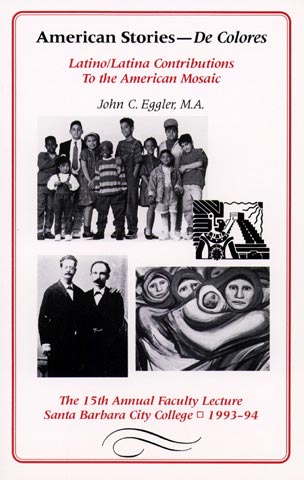
JOHN C. EGGLER was born in the border area of Nogales, Arizona. Living in this area influenced the development of his bilingualism and biculturalism, and created in him a great love for Mexican and South-western history.
He came to Santa Barbara in 1958, where he attended local schools. After high school graduation, he attended the University of California at Santa Barbara. After a year at UCSB, he attended Santa Barbara City College because of illness and financial constraints. John believes the education he received at SBCC was instrumental in preparing him for upper division work. The excellence in teaching and the compassion of his instructors made him decide that he wanted to be a community college teacher. To this day, he has a deep love for SBCC, with its continuing reputation as one of the best two-year colleges in the nation.
HE RETURNED TO UCSB and majored in Latin American and African History, receiving his B.A. and M.A. degrees. While at UCSB, he was awarded a fellowship by the Center for the Study of Developing Nations. He later began his doctoral work in the School of Education, combining English as a Second Language, Bilingual Education and Anthropology.
John joined the staff of SBCC in 1970 to teach Latin American, African and Mexican-American History. He developed Chicano History and Culture classes, and worked with Alfonso Hernandez, David Lawyer, Jr. and Pablo Buckelew in creating the college's American Ethnic Studies Program.
IN THE NEXT few years, he returned to UCSB to take course work in ESL and Bilingual Education. With this preparation, he also taught ESL for a few years.
John's interest in the learning processes of foreign students and in the need for American students to become acquainted with foreign cultures led to his involvement in SBCC's Education Abroad Program. He has taken student groups to Cambridge, England, and Salamanca, Spain. He has also served as faculty adviser to various clubs, including MEChA.
HE HAS BEEN the chair and co-chair of the American Ethnic Studies Department. He has also served three times on the Academic Senate Representative Council and was chair of the Faculty Enrichment Committee for three years. Currently, he is chairperson of the History Department.
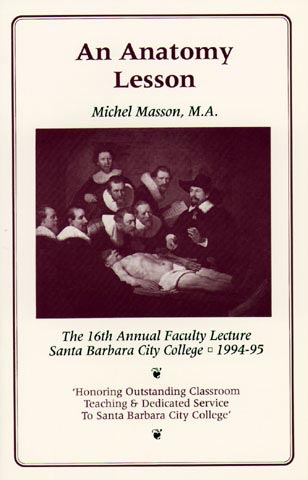
MICHEL "MIKE" MASSON was born in California; his family moved to Santa Barbara when he was seven years old. He attended local public schools (Peabody, La Cumbre Junior High, Santa Barbara High), and considers himself an "almost-native" Santa Barbaran. His real education, however, was at the Santa Barbara Museum of Natural History and in Mission Creek, where he spent afternoons and summers catching frogs, snakes, lizards, turtles, and insects. "I have been a biologist since before I could talk", he says. "My earliest pre-verbal memories are of hearing a barn owl shriek, watching a king snake climb a rock wall, and finding a little brown bat sleeping under a mulberry leaf."
AS A TEENAGER he worked after school every day at the Museum of Natural History, preparing
specimens, constructing exhibits, and caring for the many orphaned and injured animals
at what was in those days Santa Barbara's only "zoo" and wildlife care facility. Weekends
and summers found him hunting and camping in the Los Padres and chasing snakes in
the deserts of California and Arizona.
MIKE THEN ATTENDED UCSB, where he received what he calls "one of the last classical educations in zoölogy", graduating in 1963 with a B.A. During his college years he spent his summers in the outdoors working first for the California Division of Forestry and then for the United States Forest Service, as a firefighter, trail builder, and back-country ranger. After graduation he returned to UCSB to spend two years as a Research Laboratory Technician in the laboratories of Elmer Noble (Parasitology) and Edward Triplett (Embryology), then two years as a graduate student, receiving his M.A. in 1967.
HE APPLIED FOR A TEACHING JOB at SBCC but, through a twist of fate, was offered a position of Lecturer at UCSB teaching Human Anatomy, a field he had never studied or even thought seriously about but which was to prove both interesting to him and much in demand in the academic marketplace. With three years experience in that position he was able to move to SBCC in 1970, where he has remained ever since, happily teaching courses in Human Anatomy, Human Physiology, Introductory Biology, and Physical Anthropology. After 28 years of teaching subjects that apply the principles of biology, zoology, and evolution to the human species he is pleased to describe his academic specialty as "Human Biology."
IN HIS SPARE TIME, which he guards jealously, Mike enjoys motor-cycling, bicycling, mountain biking, hiking, camping, backpacking, trout fishing, SCUBA diving, reading cheap French detective fiction, and searching San Francisco for new Dim Sum joints and Italian restaurants. Married for 30 years, he and his wife, Elona, live in Goleta. Their son, Sam, attends City College.
GARY L. CARROLL is a native Southern Californian who, with the exception of his military service overseas, has lived here all his life.
A childhood fascination with how and why things worked, coupled with an early aptitude for math and science, led him to enroll at UCLA as a math major. After a year of classes he found his chemistry courses to be more interesting and changed majors, earning a B.S. in Chemistry. He entered the Ph.D. program at UCLA, but was drafted into the Army after two quarters of graduate study. He returned to UCLA after his military training and a 14 1/2 month tour of duty in Vietnam to complete a Master of Science Degree in Chemistry.
In 1974 he was hired by Golden West College as an Instructional Associate in the Chemistry Department, where he was in charge of an open laboratory program. Here students from several different levels of chemistry classes completed experiments any time within a given week. In addition, he taught General Chemistry in the evening college program.
HE JOINED THE Chemistry Department at SBCC in 1976 and, after a semester of teaching, enrolled as a full-time graduate student at UCSB, where he worked for Dr. R. Daniel Little and pursued studies in synthetic organic chemistry. His concurrent teaching at SBCC and research at UCSB continued for 5 1/2 years and culminated in the awarding of the M.A. and Ph.D. degrees.
In 1981 he became SBCC Chemistry Department Chair, a position he has continuously occupied. He has served on numerous college committees, including Safety, Curriculum, Media Resources and others. He was Vice President of the newly formed Instructors' Association and helped write that organization's constitution and bylaws.
After a number of years as a member of the Representative Council of the Academic Senate, serving as a Representative and Vice President, Dr. Carroll was elected President in 1991. It was during his term as President that SBCC changed to the early calendar and major organizational changes were made in the Senate.
HAVING COMPLETED his term as Academic Senate President at SBCC, he served for two years on the Local Senates Committee of the Statewide Academic Senate, with responsibility for developing and maintaining a database of all the community college academic senates and coordinating information for eight local community colleges.
His fascination with how and why things work continues, sometimes finding expression in designing and building. Dr. Carroll also enjoys camping, hiking and traveling . . . and trying to show his students the lighter side of life.
DAVID N. LAWYER, JR. was born in New York City; he was part of the first wave of "baby boomers." He grew up in Harlem, a rich and vibrant community, and attended elementary schools there. His family moved to California, first to Los Angeles and later to Oxnard. After a successful career at Oxnard High School, where he was Student Body President, Valedictorian and All-American basketball player, he matriculated at Princeton University. David began his collegiate studies as an engineering student, but later shifted to the field of political science. His senior thesis, for which he received a department award, was entitled "The Black Badge: A Study of Black Police Officers in New York City." He continued with his athletic endeavors, playing basketball on several nationally-ranked teams and competing in track and field. He was also a member of the Cottage Club. David graduated from Princeton with an A.B. degree in 1968.
David intended to enroll in law school, but that opportunity was not available due to the war in Vietnam. So, he entered the profession that many of his family members had pursued for generations-education. In 1968, he began teaching at the Thacher School in Ojai. The following year, he was offered a position in the Department of History at the University of California, Santa Barbara, teaching two upper-division courses in African-American History. ln November 1969, David became a member of the faculty at Santa Barbara City College. He continued to teach at UCSB in several different departments as a Visiting Lecturer until 1977. During this period, David pursued a graduate course of study in Political Science at UCSB, where he received an M.A. degree (cum laude) in 1971 and a C. Phil. in 1974.
AT SBCC, DAVID has taught in several departments and is currently Professor of American Ethnic Studies and Political Science. He was instrumental in the creation of the American Ethnic Studies Department in 1972, of which he has served as Chair since its founding. In the American Ethnic Studies Department, he teaches courses in African-American History and Racism in America; in the Political Science Department, he teaches courses in American Government and Politics, and Law and Society. Over the years, David has held several faculty leadership positions, as a member of the Representative Council of the Academic Senate, a member of the Ad Hoc Committee on Reassigned Time, and Social Science Division Chair. He is currently Chair of the EOPS/Financial Aid Advisory Committee. He is particularly proud of his role in the development of the early calendar.
David is married to the former Tracey Scott of Inglewood. She is a homemaker and a student at California State University, Northridge (Ventura Campus). They have four children: David (27), Kerry (24), Tracye (19) and Kymberly (3). They also have two grandchildren: Jamil (5) and Andre (4).
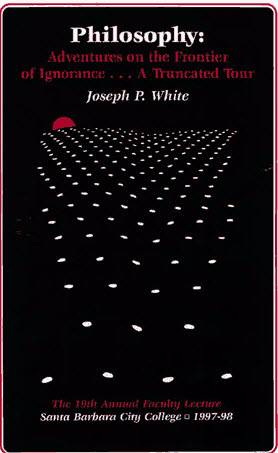
Joe White, the name says it all. An average, rather ordinary male born to very kind, somewhat pious, parents in the mid-20th century A.D. (or C.E.) in the Midwest of the United States. The eldest son in a Catholic family, Joe attended a Catholic high school seminary with the individual and collective expectation of becoming a priest. By his senior year, he found the study of history and psychology, specifically Freudian analysis, not only extremely fascinating, but undermining of his religious faith.
Going to university as a pre-law major, Joe changed his major the last of his freshman year as his interest in psychology grew. During his sophomore year, taking his first philosophy course, he discovered an academic discipline at once ancient and comprehensive which not only explored the myriad presuppositions of all other disciplines, but was also bloody difficult, at least for him. In his youthful, undergraduate years, only philosophy seemed unprovincial and methodologically unfettered by presuppositions. The decision was made to double major, since psychology might at least prove practical. At the mid-point of his senior year, he met and fell in love with the beautiful actress and student, Dulcie Sinn.
WHILE THE LURE of graduate work in psychology and the thought of going to medical school, with it all culminating in a lucrative psychiatric practice, was extremely tempting, philosophy still demanded attention. Continuing in his formal studies, Joe accepted a philosophy graduate position and research fellowship at the University of Calgary. Having married Dulcie, Joe and his new bride ventured to Calgary, Alberta. After two years in a thriving, challenging, cosmopolitan department, Joe finished his graduate work in Calgary. He and Dulcie both accepted graduate positions at UCSB.
In Santa Barbara, while a graduate student at UCSB, Joe happened into an adjunct faculty position at SBCC. What an experience those first classes were with all of those fresh faces coming to philosophy for the first time. Additionally, by 1985, he also acquired the full-time position of being a father to Nicholas. Within the next four years, Sarah was born. With two children and his still loving, supportive wife, Joe remained in love and fascinated with philosophy at SBCC, in the daily company of a bright, dedicated group of colleagues.
IN 1990, JOSEPH accepted, after stringent national and local competition, a full-time position at SBCC in the Department of Philosophy. He immediately assumed the position of department chair. The children are much older now, and Joe and Dulcie just celebrated 25 years of marital adventure in December 1997. Teaching has allowed Joe the opportunity to remain close to his love of philosophy, and SBCC has provided Joe with a rich environment within which to flourish.
While at SBCC, Joe has lectured in all courses the department offers, except Comparative World Religions. He has also designed and taught short courses in Political Philosophy (using his textbook, Assent/Dissent), Philosophy of Science, Philosophy of Religion and a special course on Bertrand Russell. He has served as Chair of the department since 1990; served on the Faculty Enrichment Committee; served a three-year term as the Academic Senator from the Social Science Division; participated in the Spring 1996 Cambridge, England Study Abroad Program and the 1998 London Study Abroad Program; written articles for the Faculty Voice; guest lectured for a variety of departments; and been keynote speaker for a number of Faculty In-Services. He organized the Peter A. Angeles Colloquia for five years, bringing individuals with national and international reputations to SBCC.
AMAZINGLY, HIS FAMILY still loves him nearly as much as he loves them. Joe White-truly an average, ordinary man on the street.
Manoutchehr Maximilian Eskandari-Qajar (Kadjar), "Manou," was born in 1956 in Vienna, Austria, of a Persian father and Austrian mother. The first 20 years of his life were spent in Austria and Iran, with regular vacation visits to Beirut, Lebanon, of which he has some of his fondest childhood memories. He was educated in turn at the French Lycée of Vienna and the French Lycée of Tehran (Lycée Razi). He received his baccalauréat in philosophy and French literature in Vienna in 1975, and went on to study political science and international law at the University of Vienna with the ultimate goal of a career in international law and diplomacy.
In 1980, while working on his dissertation on the politics of oil in Persia, he was accepted to Cambridge University, Downing College, to continue his studies in international law, but instead took a Fulbright Scholarship to study at the University of California, Santa Barbara. While at UCSB, he changed his emphasis from international relations to political theory, extended his stay to earn a doctorate in that field, and changed his career goal from the practice of politics and diplomacy to that of teaching these subjects.
In 1984, he received his Ph.D. from UCSB, with a dissertation on the Young Hegelians and began to teach there almost immediately, as adjunct lecturer in political science. In 1991, he was honored at that institution by being elected by its student body as Professor of the Year.
Manou Eskandari came to SBCC in 1992, as full-time faculty member of the Political Science Department. At SBCC, he has taught courses in political science and history, directed the Honors Program, and, most recently, pioneered two new initiatives for SBCC: In 1996 he brought to campus Phi Theta Kappa, the international honor society for two-year colleges, and in 1997 he launched SBCC's Washington, D.C. Program, which completed its first stay in Washington in Fall 1998. For his work with Phi Theta Kappa, he was honored with that society's Paragon Award for new advisors in 1998.
On his father's side, Manou Eskandari is a member of the Qajar (Kadjar) royal family, which ruled Persia from 1795 to 1925. The Eskandari branch of the Qajars were intimately linked with the Iranian intellectual and political scene, on both sides of the divide: as staunch monarchists and even stauncher democrats. In the 20th century, the Eskandaris were pioneers of the Iranian constitutional movement, founders of the Social Democratic Party of Iran, and, later, founders of the Communist Party of Iran, cabinet members, governors and members of Iran's parliament. Many of them paid for their cherished principles with their lives and fortunes. In his own life, Manou Eskandari has tried to reflect the sense of honor and leadership his family has exemplified throughout.
Manou Eskandari lives in Santa Barbara, and is married to Fariba Eskandari (Nasri). They have two children, Amir-Hamsa and Yasmin Eskandari.